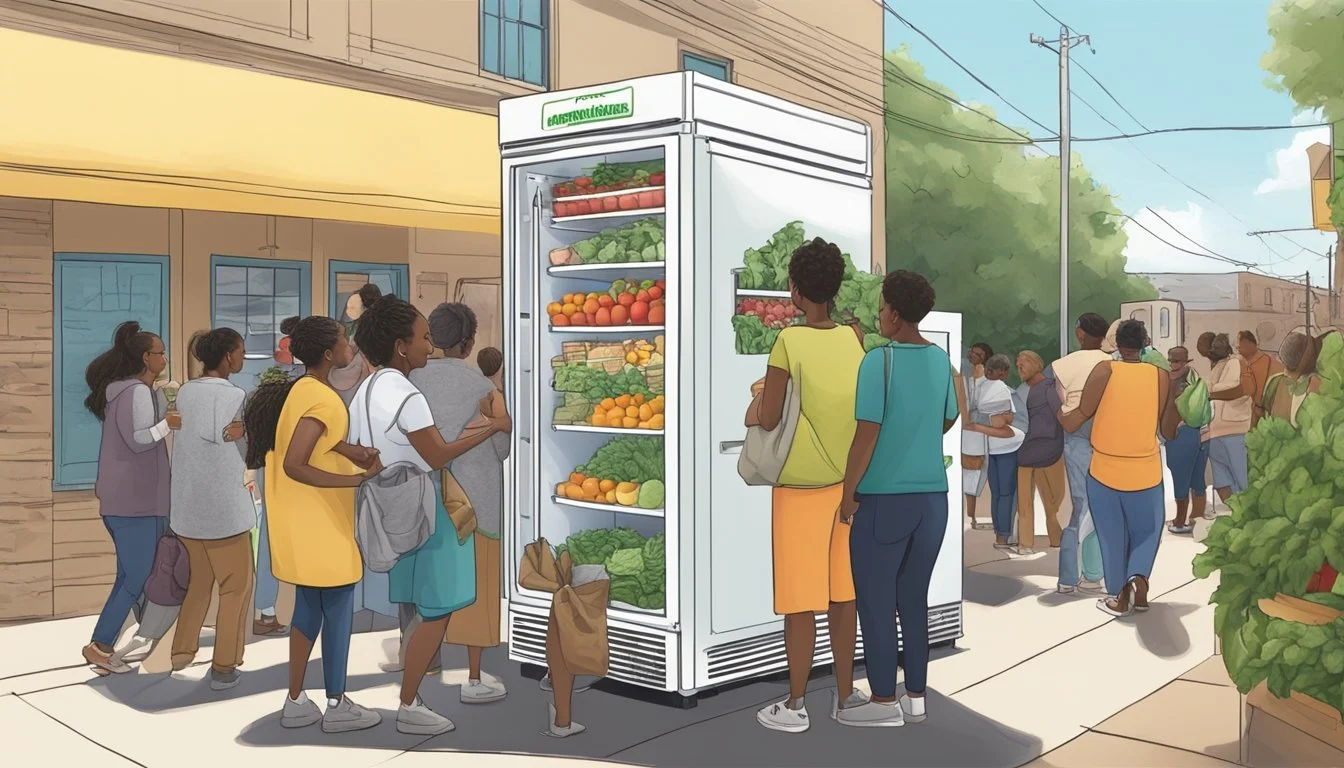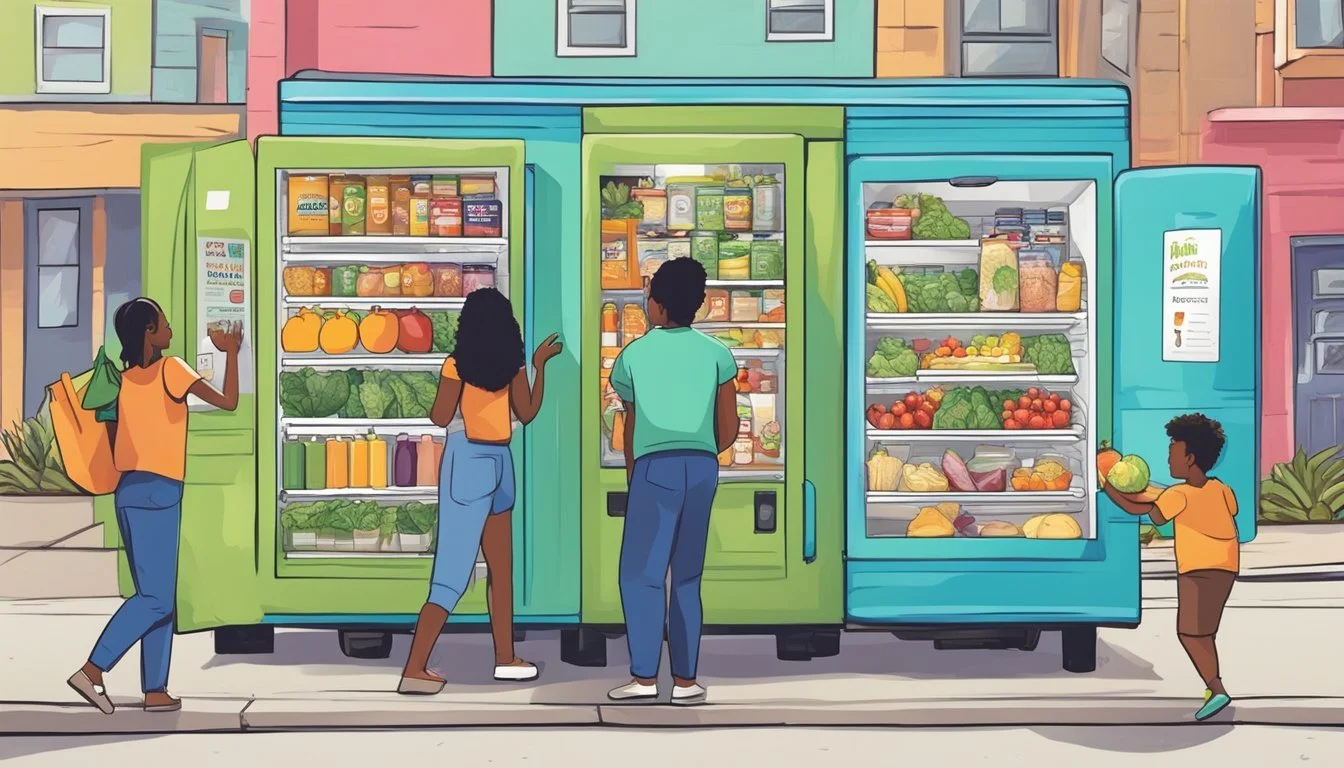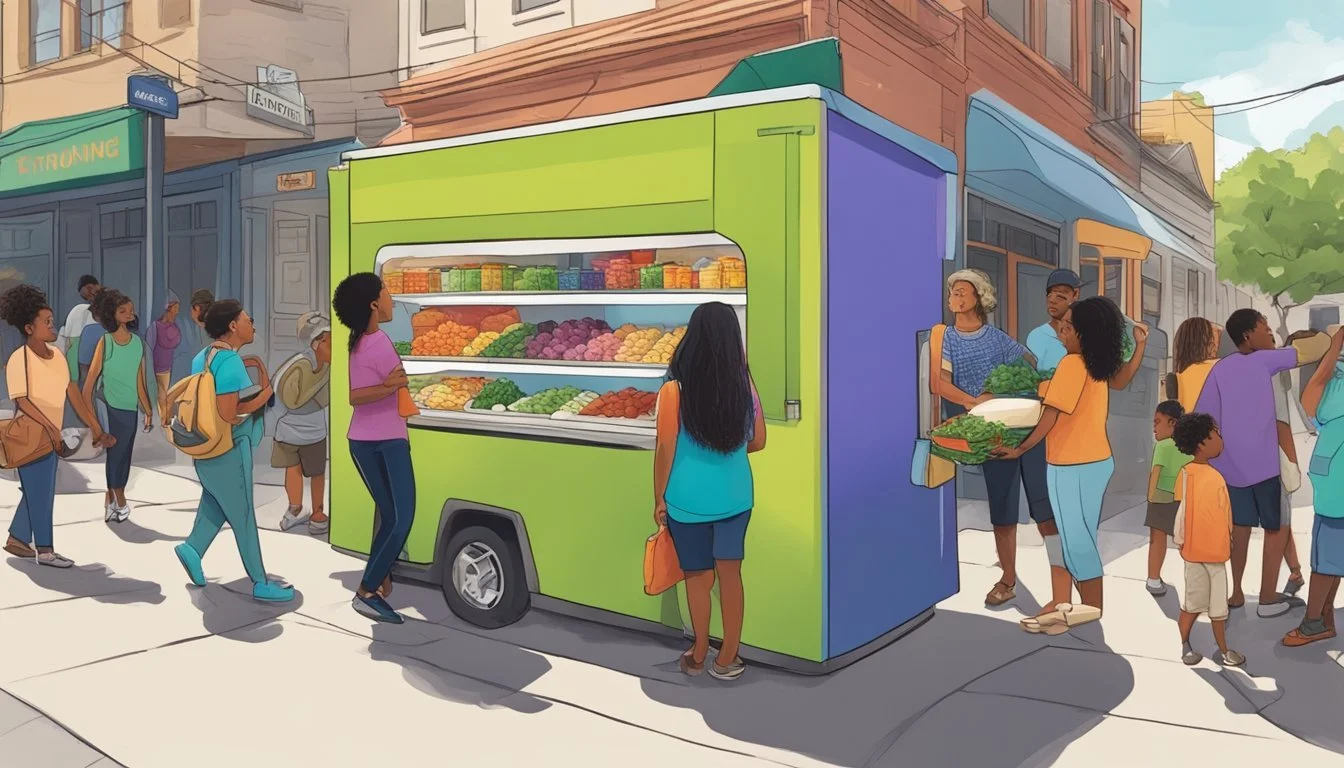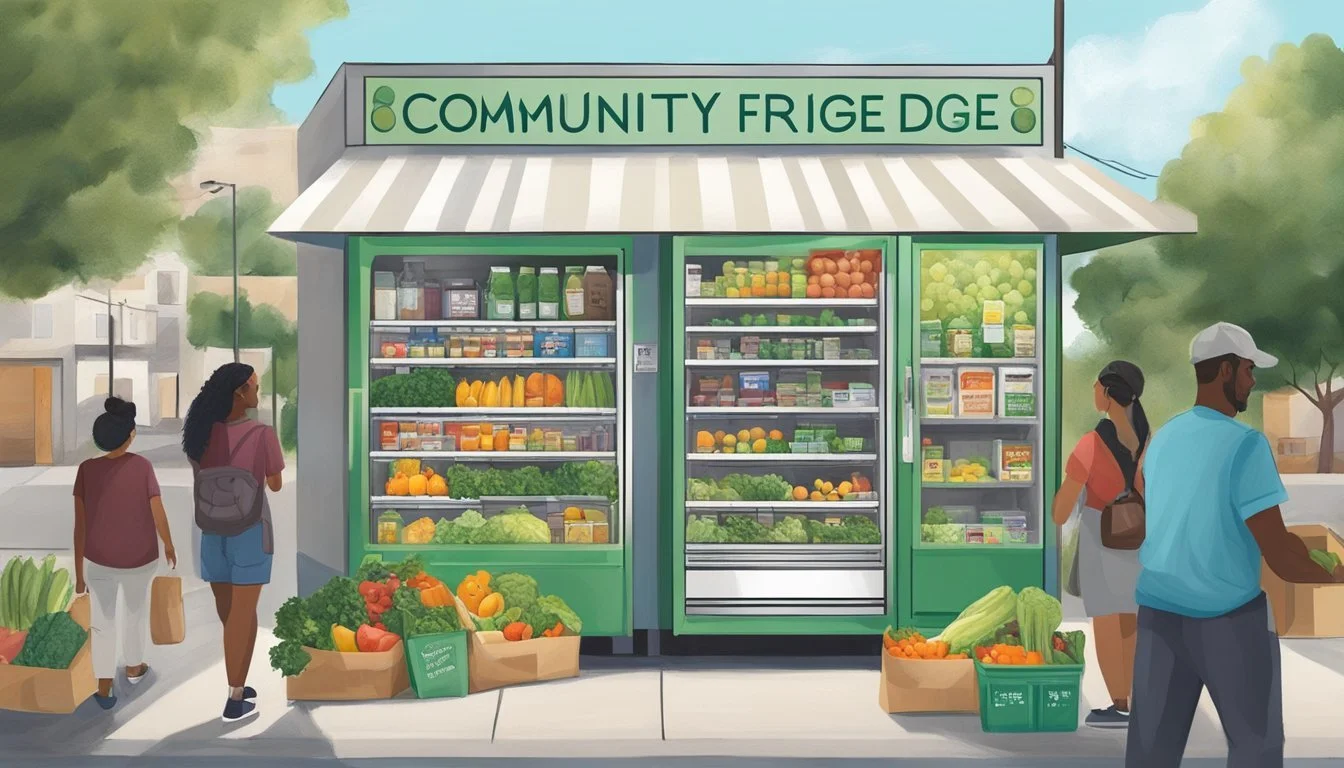San Antonio, TX Community Fridge
Addressing Food Insecurity with Compassion
In the heart of San Antonio, TX, a movement to combat food insecurity and promote sustainability is gaining momentum through the establishment of community fridges. These refrigerators are stationed at accessible locations and are filled with surplus food provided by local businesses, individuals, and donations. They operate on a simple principle: take what you need, leave what you can. This initiative not only provides access to nutritious food for those in need but also fosters a sense of community and collective care, bridging the gap between food waste and food scarcity.
The ethos behind the Community Fridge in San Antonio is founded on inclusivity and support for all members of the community. One distinct fridge in this network offers only plant-based food options. This particular approach not only caters to specific dietary preferences and needs but also aligns with a sustainable and environmentally-friendly mindset. Such fridges are accompanied by clear guidelines to ensure contributions are safe and appropriate, such as the exclusion of meat, dairy, expired foods, or homemade meals.
Fundraising efforts, such as those organized through platforms like GoFundMe, have also played a pivotal role in supporting the Community Fridge initiative. By pooling resources from the community, these fridges are continuously stocked and maintained, reflecting a collective investment in the well-being of San Antonio's residents. Through this shared commitment, the Community Fridges in San Antonio symbolize a beacon of hope and solidarity, illustrating the positive impact of cooperative action within a community.
Concept of Community Fridges
Community Fridges, or "freedges," are a practical approach to address food insecurity and minimize food waste through a system of shared and free access to food.
Definition and Purpose
Community Fridges represent a simple but effective mutual aid concept where refrigerators are placed in public spaces to store surplus food. They operate on the principle that anyone can take what they need and leave what they don't, promoting resource sharing and community cohesion. Food insecurity is a critical issue they address, enabling easier access to nutritious food, especially for those who may be financially struggling. Additionally, these fridges help to combat food waste by providing a place for businesses and individuals to donate food that would otherwise be discarded.
History and Origin
The first community fridges began popping up in Germany, where public refrigerators were set up to share food within local communities. Since then, the idea has spread internationally, becoming a grassroots movement in many cities. These fridges often emerge in response to the recognition of food disparity issues in urban and rural settings, as well as the environmental impact of throwing away good food.
Community Fridge Movement
The Community Fridge Movement is characterized by a spirit of collaboration and voluntary contribution. It has gained prominence as a practical form of mutual aid, where community members support each other without expecting anything in return. The movement's expansion is largely driven by non-profit organizations, local businesses, and volunteers who maintain the fridges and ensure they are stocked with healthful food options.
San Antonio's Community Fridges
San Antonio's community fridges are a grassroots effort aimed at combating food insecurity by providing easily accessible and free nutritious food to local residents.
Locations and Sponsors
Community fridges in San Antonio are strategically placed in areas with high need to ensure they are within reach for those who need them most. One notable fridge is hosted by Swift Movers LLC, situated at 1316 Austin Street, which is a central location near East Grayson and Broadway streets. The visibility and accessibility of the fridge locations are enhanced through partnerships with local businesses and organizations willing to share their accessible spaces for these community resources.
Managing Organizations
The initiative of community fridges in San Antonio is backed by various local groups working to connect communities, alleviate hunger, and reduce food waste. These organizations not only manage the operation and maintenance of the fridges but also oversee the regular donation of plant-based foods and personal hygiene products. The San Antonio Food Bank, known for its large-scale food distribution events, plays a pivotal role in addressing food insecurity and is a key player in supporting the mission of community fridges.
Impact on Local Communities
Community fridges have had a significant impact on local communities in San Antonio. With the aid of these fridges, thousands of residents have found a reliable source of free, nutritious food, which has been particularly important for those experiencing food insecurity. The presence of these fridges promotes a sense of community solidarity, as businesses, individuals, and the San Antonio Food Bank come together to support their neighbors in need. This strong community partnership is instrumental in not just offering food but also in fostering connections among San Antonio residents.
How Community Fridges Work
Community Fridges in San Antonio operate as public amenities offering fresh food to those in need. They rely on community support and strict adherence to food safety guidelines to ensure sustainability and safe consumption.
Operation Model
Community Fridges are refrigerators placed in accessible locations where they can be used by individuals and families to obtain fresh food at no cost. They primarily run on a "take what you need, leave what you can" principle, encouraging contributions of surplus food from:
Local businesses: These often include grocery stores, cafes, and markets that donate excess fresh produce to prevent waste.
Residents: Individuals can donate store-bought and unexpired food that is in good condition.
Donations: Monetary or in-kind contributions aid in the maintenance and stocking of the fridges.
Do Don't Donate fresh produce and unopened foods Leave expired, open, or homemade items Check the fridge’s cleanliness and organize as needed Overstock to the point of overflowing
Food Safety Guidelines
To ensure that food remains safe for consumption, specific guidelines must be followed:
Plant-Based Only: In certain Community Fridges, like the one in San Antonio mentioned in the search results, only plant-based foods are accepted, excluding meat and dairy products.
Expiration Dates: Donations must be within their consuming dates, and any expired items are to be removed promptly.
Hygiene Products: Many fridges also welcome personal hygiene products which should be new and sealed.
Acceptable Items Prohibited Items Fresh fruits and vegetables Meat and dairy (for vegan fridges) Sealed pantry goods Opened packages Non-perishable food items Home-cooked meals (how long do cooked meals last?)
Community Engagement and Sustainability
A successful Community Fridge depends on active community involvement, from regular donations to volunteer work for maintenance and organization. They serve not only as sources of nourishment but also as hubs for civic engagement. Strategies to promote sustainability include:
Education: Informing the public about the proper use of Community Fridges and the impact of food waste.
Volunteers: Individuals contribute their time to monitor and clean the fridges, ensure compliance with guidelines, and sometimes help redistribute food to avoid spoilage.
Funding: Community Fridge initiatives often set up donation platforms such as GoFundMe to ensure they can purchase fresh food and maintain operations.
Supporting Food Security
In addressing the issue of food insecurity in San Antonio, Community Fridges serve as a beacon of hope. They offer an innovative approach to make surplus perishable food freely available, supporting a broad spectrum of community members.
Addressing Food Deserts
Food deserts are areas that lack convenient access to affordable and nutritious food. San Antonio's Community Fridges aim to combat this by being situated in accessible public spaces. These fridges help to redistribute food that would otherwise go to waste, benefitting regions of San Antonio that experience these critical gaps in food availability.
Benefiting Various Demographics
The Community Fridge initiative in San Antonio does not discriminate—people from all walks of life can reap the benefits. By saving households and community groups overestimated thousands in food costs and providing substantial quantities of redistributed food, the impact on the community's daily life is marked and measurable.
Collaborations with Local Entities
Local entities and individuals are the backbone of the Community Fridge network. This includes donation drives, fundraisers, and collaborations that ensure a steady supply of plant-based foods and hygiene products. For instance, community-driven fundraising efforts have managed to surpass their financial goals substantially, reflecting robust local support for the sustenance of these fridges.
Contributing to Community Fridges
In San Antonio, TX, individuals and organizations can support community wellness by contributing to community fridges. These fridges are designed to redistribute food and reduce waste, providing accessible nutrition options for all.
How to Donate
To make a contribution to a community fridge, donors can contact the host organization, typically a local business or nonprofit, to learn about drop-off times and locations. Donations should be coordinated with the fridge managers to ensure they meet the safety and quality standards.
Drop-off Times: Usually during business hours
Location: Specific addresses of host organizations
What to Donate
Community fridges mainly accept perishable food items that are fresh and safe to consume. Contributors are encouraged to donate:
Vegetables: Fresh produce that is clean and not spoiled
Fruit: Preferably non-bruised and ripe for immediate consumption
Plant-Based Foods: Items that cater to various dietary restrictions
Donations should be labelled and dated to track freshness and ensure proper rotation. Homemade meals or opened packages are typically not accepted due to health regulations.
Volunteer Opportunities
Community fridges thrive with the help of volunteers. Opportunities include:
Stocking the Fridge: Organizing food donations
Cleaning: Maintaining cleanliness and hygiene standards
Outreach: Educating the community on how to participate
Volunteers can sign-up through the host organization's website or by visiting the fridge location in person. Volunteer work ensures the sustainability of community fridges and enhances their impact.
Impact of COVID-19
The onset of COVID-19 significantly increased the challenges associated with food insecurity in San Antonio, prompting community-driven responses such as the operation of community fridges.
Increased Need for Food Aid
The pandemic exacerbated existing food access issues, leading to a heightened demand for food assistance. Community fridges in San Antonio became a crucial resource for residents facing financial hardship and food scarcity.
Adapting Community Fridge Operations
To comply with health guidelines and ensure safety, community fridge organizers implemented new protocols. They ensured regular sanitization of the spaces and managed socially-distanced access to help curb the spread of COVID-19 while continuing to provide essential services.
Challenges and Solutions
Community Fridges in San Antonio face specific challenges in their operation, most notably maintaining the stock and quality of the food they offer, as well as ensuring food safety and overall cleanliness. Addressing these issues is critical for the initiative's success and its ability to serve the community effectively.
Maintaining Stock and Quality
Maintaining a consistent stock of fresh and high-quality food items is a primary challenge for Community Fridges. They rely heavily on donations from local businesses and individuals. To manage this:
Regular Checks: Volunteers perform daily checks to assess stock levels and expiration dates.
Community Involvement: They encourage community members to donate surplus food, ensuring a variety of healthy options are available.
Ensuring Safety and Cleanliness
Food safety and cleanliness are pivotal in the operation of Community Fridges, to prevent foodborne illnesses and maintain community trust. Strategies include:
Strict Guidelines: Establishing clear food safety protocols, such as not accepting raw meat or expired products.
Regular Cleaning: Scheduling frequent cleaning and sanitization of the fridge space to uphold hygiene standards.
Economic Aspects
The Community Fridge in San Antonio, TX operates with a financial framework that not only supports its own sustainability but also contributes to the economic well-being of the local community.
Funding and Expenses
Funding Sources:
Donations: Community contributions and food donations are fundamental to the fridge's operation.
Crowdfunding: Platforms like GoFundMe facilitate monetary support for purchasing supplies.
Sponsorships: Local businesses sometimes support by providing funds or resources.
Key Expenses:
Rent: Hosting sites like businesses may offer space at no cost, keeping overhead low.
Electricity: Essential for refrigeration, these costs are ongoing and depend on the fridge's usage.
Supplies: Non-food items, such as cleaning materials and personal hygiene products, are periodically needed.
Economic Benefits for the Community
Food Access: By providing free access to nutritious food, it helps individuals save on household expenses.
Waste Reduction: Local businesses donate surplus food, reducing waste and associated costs.
Community Engagement: It fosters a community-driven support system that can indirectly enhance local economic vibrancy through collaborative engagement and shared resources.
Employment Impact: While the fridge itself may not be a significant direct source of employment, the initiative can contribute to community morale and local pride, elements that can influence economic stability and growth.
Future Outlook
The scalability and technological advancement of the community fridge network are crucial components in addressing food insecurity in San Antonio. These aspects underscore the sustainable evolution of food distribution and access in the city.
Expansion of the Network
San Antonio has witnessed the efficacy of community fridges in providing accessible, nutritious food to those in need. The projected expansion of this network is set to significantly bolster these efforts. By facilitating cooperation with local businesses, non-profits, and city initiatives, the goal is to install additional fridges in strategic locations. These locations will be chosen based on community needs assessments to ensure optimal impact. The growth of the network also implies an increase in community engagement, volunteer participation, and donor support, further anchoring the community fridges as pillars in the fight against food insecurity.
Innovations and Technology Integration
The integration of technological innovations is pivotal for the future performance of community fridges. Plans include the use of inventory management systems, which will streamline the donation and distribution processes. These systems aim to ensure that the food remains fresh and the restocking needs are met timely. Future technology proposals also include energy-efficient refrigeration units, which could expand the lifespan of perishable donations and reduce operational costs. Additionally, apps or platforms for coordinating volunteer efforts and educating the public on nutrition and food waste could significantly enhance the efficiency and outreach of community fridges in San Antonio.









